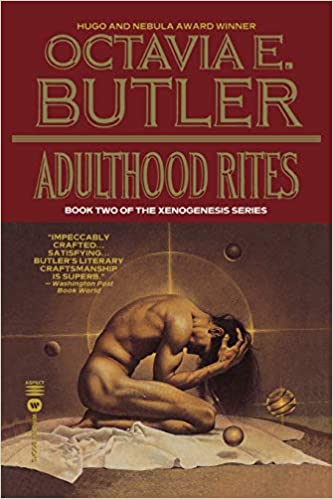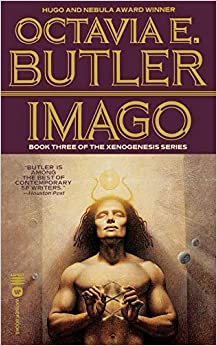Prepare for a deep dive into the most intimate details of human-alien contact in Octavia E. Butler’s Xenogenesis trilogy. Step by step she takes you through the initial encounters between a human, Lilith Iyapo, and her Oankali captors (Dawn), the coming of age of a construct resulting from this union (Adulthood Rites) and the reconciliation of human and alien through the eyes of a maturing member of the new species (Imago). (The three novels are grouped together under the title Lilith’s Brood in a Kindle edition.) It’s the most intense and brilliant rendering of the mingling of species, of colonization and racism I’ve ever read.

Octavia Butler wrote in her notebooks of how important it was to make people feel deeply through each of her novels, and the Xenogenesis trilogy is a powerful example of how well she succeeded. Her ability to capture the sensuality of human-Oankali mating far transcends most writing about sexuality but here with full recognition of issues of race, oppression and identity explored in detail.
Butler depicts a ruined earth, destroyed by a nuclear war between Russia and the United States that left tiny pockets of surviving humans, mostly in the southern hemisphere. The Oankali are an alien race that has traveled across the galaxy for thousands of years, adapting itself to one species after another. Each time it has drastically changed its appearance to make its members suitable for symbiotic relationships with others.
Arriving after the war on Earth, the Oankali rescue a few hundred humans from the nuclear devastation, put them into stasis and examine at the molecular level the conditions that caused their illnesses. Their aim is not just to learn but to cure the diseases, especially cancer, and use the new knowledge to extend human life, making them suitable mates for the Oankali and a future blended offspring.
They call this a “trade” and describe themselves as a trading people. There are many echoes of European enslavement of African peoples, especially in the Oankali perception of themselves as helping humans, even while they are subjecting them involuntarily to genetic experimentation. They map out an empty future for the humans who resist having anything to do with the Oankali, who want to preserve their humanness at all costs.
In Dawn Butler chooses Lilith as her protagonist to tell the story of how the Oankali-human interaction unfolds. Lilith is selected by the Oankali both to bear the first offspring of the union of the two species and to “train” other humans to accept the new conditions of their life under alien rule. Lilith is all too aware that her position will be seen by other humans as that of collaborator and traitor, and so it turns out as she wakens more and more of the humans from stasis.

Lilith finds an ally and mate in Joseph, but he shares Lilith’s complicated reaction to the Oankali. The only way they are to produce children is through the intermediary of an Oankali who is neither male nor female but a third sex known as an ooloi. It has the power to take genetic and gamete material from human bodies, manipulate it to construct a new kind of entity and implant the modified ovum in Lilith’s body.
The ooloi, Nikanj, lies between Lilith and Joseph, penetrating their bodies with tentacle-like arms that are the principal sensing organs of the Oankali. At first they are both repulsed by the appearance and tentacular contact, but eventually Lilith and Joseph accept it, partly because neither has ever experienced such a level of sensual power within the process of mating. While they accept it, part of them never stops fighting it. That complex repulsion-attraction is one of the elements that makes all three volumes in the series so compelling.
“She sandwiched Nikanj’s body between her own and Joseph’s, placing it for the first time in the ooloi position between two humans. For an instant, this frightened her. This was the way she might someday be made pregnant with an other-than-human child. Not now. … She never knew whether she was receiving Nikanj’s approximation of Joseph, a true transmission of what Joseph was feeling, some combination of truth and approximation, or just a pleasant fiction. What was Joseph feeling from her? It seemed to her that she had always been with him. She had no sensation of shifting gears, no “time alone” to contrast with the present “time together.” He had always been there, part of her, essential.”
Lilith’s Brood Kindle edition pp. 161-162

The overall arc of the story through the trilogy is not the usual one of conquest and rebellion but one of gradual intermingling of human and Oankali to the point where the original stark choices set before humans are modified through the agency of Lilith’s offspring. They learn more and more about human nature and the “resisters” and gradually achieve a way of reconciling the two species so that the humans who wish to remain on earth can do so.
In Adulthood Rites, the story unfolds largely through the eyes of Akin, one of Lilith’s male offspring. Human resisters, living in their own settlements in the Amazon basin, one of the still livable areas on earth, steal Akin away from his family when he is still a toddler, but one with a highly developed mind and the ability to speak quite intelligently. He looks mostly human, except for his tentacular tongue, though when he grows to maturity he will acquire other features that will make him look much more like other Oankali.
It is Akin who persuades the Oankali to create a way out for the humans who resist mating with the alien species. Rather than continue to live sterile on Earth with the prospect of simply dying out by themselves, the resister humans are offered a life on Mars where they can have children and live free of the Oankali. But what of earth? The plan is that the Oankali ships, which are themselves living things, will feed on the planet until it has been stripped bare of all life. Then the humans, the Oankali and their new offspring will leave the barren rock forever.
It is the next generation of “construct” in the person of Jodahs, the narrator of Imago, who further modifies the Oankali plan to enable the seeds of new settlements to take root in the earth so that the planet can thrive in a new way, populated by a new species that will avoid the destructive tendencies of previous human generations.
Getting to that point is a painful experience for human, Oankali and construct people alike. For me, Dawn is the most satisfying novel in the series because of its tight focus on Lilith’s impossible situation of trying to preserve her humanity while becoming the Oankali’s chosen vessel for breeding a new species. She is burdened with survivor’s guilt as well as a self-hatred due to her collaborating with alien beings and having to prepare other humans for a new life most of them don’t want.
The next two books are enthralling as the story deepens, but there is a little more backstory explanation and description of the intricacies of Oankali life. The working out of the plot becomes a bit simplistic at the end of Imago, but the design and intricacy of the whole is so absorbing, the insights into human nature so powerful, that these shortcomings were far outweighed for me by Butler’s incredible vision of the future.

Leave a Reply